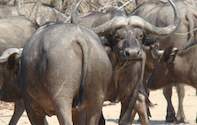
How Many Elephants in Kruger National Park?
This year the elephant and buffalo census team, under the leadership of Dr Ian Whyte, who is conducting his 24th census, counted 13 050 elephants in the Kruger National Park (KNP). Although Ian retired earlier this year, he was contracted to conduct the census.
The count indicates 623 individuals or five percent more than the 12 427 counted last year. Ian says in his report that only 338 calves were recorded which is considerably less than the 725 counted in 2006.
'But as elephants have a long gestation time and inter-calving period, a high calf percentage cannot be sustained year after year and is no cause for concern.'
According to the final report, of the total elephants counted, 1 816 were adult bulls and 11 234 were recorded in breeding herds. The western boundary fence, which separated Kruger from the Associated Private Nature Reserves (APNR), Sabi-Sand Game Reserve (SSGR) and other provincial nature reserves was removed in 1993.
The APNR comprises the Timbavati and Klaserie Private Nature Reserves, the Umbabat PNR as well as sections of the Balule and Olifants River North game reserves. Since then elephants have moved freely between the park and these protected areas and have also been counted annually.
'The Sabi-Sand has been the only exception as they have chosen to conduct their own censuses and the results for this and some other areas have been made available by Dr Mike Peel of the Agricultural Research Council (ARC).' Part of the Limpopo National Park (LNP), bordering Kruger to the east, was censused in 2006, but there was no census in 2007.
Excluding the LNP, in 1992 a total of 603 elephants roamed the protected areas adjoining Kruger. In 2007 the total number of elephants recorded was 3 158. For the first time, this year the data was captured on to CyberTracker units, and not directly on to 1:100 000 maps, as had been done for the last 20 years.
Learn more about Elephant Population Numbers in Kruger
Buffalo

With this year's buffalo census it was decided not to photograph the buffalo as in previous years, but to simply estimate buffalo herd sizes. 'The reasons were to try to avoid splitting the herds, as it had been suggested that elements of herds then break away and join up with other herds, and in this way facilitate the spread of bovine tuberculosis (BTB),' says Ian.
'As it turned out, buffalo are extremely fearful of helicopters and most herds split anyway as they stampede at the sound of a helicopter,' he added. There would also be less time spent in the air and on counting and analysis.
This meant that comparison of data to previous years is not strictly valid, but is included for the sake of completeness. Although not much attention should be given to the trends, a decline in the population is not likely as there was no excessive mortality or sparse enough grazing to limit population growth.
According to the report, the buffalo population in Kruger declined by 52 percent from 29 359 to 14 123 between 1991 and 1995 due to the devastating droughts of those years.
With the higher rainfall and improved habitat over the next two years, the population halted its dramatic decline and, apart from 2003, the buffalo population in Kruger has steadily increased.
It has now regained levels prior to the drought declines and in 2006 the population increased by 2 246 from 31 062 in 2005 to 33 308. In 2007, it was estimated that 30 907 buffalo could be found in Kruger. Of these 2 180 would be bulls.
Learn more about the African Elephant and Buffalo

